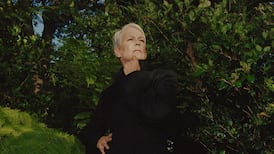In the larger pantheon of cult cinema, few titles have the staying power – or the fishnetted pizazz – of The Rocky Horror Picture Show.
First staged in a tiny upstairs space – with 60 seats in total – at the Theatre Royal in London in 1973, the bizarro, brilliant and singalong musical The Rocky Horror Show somehow evolved into a theatrical warhorse and midnight movie juggernaut.
Remarkably, Strange Journey: The Story of Rocky Horror, a new documentary directed by Linus O’Brien, son of Richard O’Brien (who wrote the original stage show and starred as Riff Raff in the 1975 movie), is the first feature-length project to chronicle the musical’s buoyant history.
“It’s very strange,” says the director. “A lot of people have commented on how weird it is that something like Rocky hasn’t been given this kind of attention and on this scale before. I feel very privileged and lucky to be the one to do it, to be honest. I’ve known the story for so long. I’ve known my dad’s personal journey. It was really a question of taking everything that I knew and making sure it got on camera.”
READ MORE
The Rocky Horror Picture Show follows a newly engaged couple, Brad and Janet (played by Barry Bostwick and Susan Sarandon), as they stumble upon a mysterious castle after their car breaks down. Inside, they meet Dr Frank-N-Furter (Tim Curry), a flamboyant, cross-dressing scientist, who unveils his latest creation: a muscular, artificially-made man named Rocky. As the night unfolds, the couple is drawn into Frank-N-Furter’s riotous world of sexual liberation and showstopping musical numbers.
“You can put on your favourite album, pretty much anytime, and revisit it,” says O’Brien. “That’s another huge strength of Rocky. If the songs were only half as good as they are, we wouldn’t be talking about it today. But the songs are as good as any other soundtrack that’s ever been written. Obviously, I’m biased, but you can put it next to The Wizard of Oz and West Side Story, in my opinion.”
Whereas many lavish, starry West End productions have floundered, Rocky Horror logged some 3,000 productions on its first run and has endured for over five decades, outlasting many other pop culture trends. No other musical can compete with Rocky’s global fan clubs, nor the shadow casts that re-enact its every move in real time.
O’Brien’s new film brings together various fans, including Jack Black and Trixie Mattel, plus the original cast and creatives to recount the rollicking fall and rise of the scrappy, queer-favoured musical. We also encounter Tim Curry, whose outrageous turn as the intergalactic, polyamorous Frank-N-Furter is a huge part of its enduring cult appeal.
I would consider Star Wars a cult. I would consider Harry Potter a cult. But Rocky stands out because it is one of the largest and definitely the first in many ways
— Linus O'Brien
Post Rocky Horror, Curry went on to have a Hollywood career in It, Legend, and Clue. Sadly, the beloved actor suffered a stroke in 2012. He uses a wheelchair and has required assistance with daily tasks ever since. Aside from voiceover work, Strange Journey marks Curry’s first film appearance since 2010.
“It took about six months to get Tim Curry on board. Not because he was resistant – it was more a question of scheduling and timing,” O’Brien says. “Everyone else was very accommodating. I have a lot of personal connections, which really helped. I obviously have a front-row seat to my dad’s work, and I’ve heard all the stories over the years in different parts. So when it came to doing interviews, I could ask questions I kind of already knew the answers to, and still gain more insight.”
[ Richard O’Brien: I don’t know that we could make The Rocky Horror Show todayOpens in new window ]
The show’s original cast – including Curry – brought the production to Los Angeles in 1974, where it lit up the stage at The Roxy. The film version followed shortly after, shot on a shoestring budget, while the show was gearing up for a Broadway debut. The Broadway production folded quickly after 45 performances and some unkind reviews. The film adaptation similarly flopped upon release in 1975. Audiences were confused by the unconventional mix of sci-fi, horror, camp and sexual themes.
However, it found new life through midnight screenings, particularly in New York. Fans began dressing up as characters, shouting lines at the screen, and creating a unique interactive experience. The movie’s mantra – Don’t dream it, do it – resonated deeply with marginalised groups, including the LGBTQ+ community. The raucous late-night screenings at the Classic in Harold’s Cross were a Dublin legend up to the cinema’s closure (with, of course, a last outing for Rocky Horror) in 2003.
One of the people featured in the documentary is Sean Waters, who was once a homeless runaway.
“He talks about how he was safe from 10 to four every Friday and Saturday night at screenings,” O’Brien says. “His story speaks for thousands, maybe hundreds of thousands. It was a place people could go and be themselves before we even had the phrase ‘safe space’.”
O’Brien is still moved by what Rocky achieved.
“It’s overwhelming sometimes,” he says. “Rocky has tangibly saved lives. After our premiere at South by Southwest, a man came to the stage and said, ‘If it wasn’t for Rocky Horror, my wife wouldn’t be alive.’ Those moments stick with you. It’s much deeper than just frivolous fun. Rocky created a real sense of community for people who’ve felt disenfranchised or marginalised, not just because of sexuality or gender, but because they never quite fit in.”

The subject matter is close to home for the director, who movingly films his father’s return to the New Zealand street where he spent his teenage years. Rather appropriately, the good people of Hamilton have erected a statue of Riff Raff in the town centre. It’s a lovely scene that plays like a home movie.
“I’ve never known my life without Rocky Horror in it,” says O’Brien, who was less than a year old when his father’s musical became the talk of London. “It keeps popping in at different times, like at conventions or new stage productions, or anniversaries. It has just always been in the background for me. I have a real personal relationship to it over the years, and I’m continually very influenced and surprised by the relevance Rocky has today.”
In some of the documentary’s most teary scenes, O’Brien senior discusses his lifelong struggle with gender identity, describing himself as existing on a spectrum between male and female. He has stated he feels 70 per cent male and 30 per cent female and has used oestrogen to balance his hormones, finding it helped with his sense of self.
“My dad doesn’t like to go too deep emotionally, because he’s so sensitive. We both are. So when he opened up in the film, it came out in a natural, light way,” the younger O’Brien says.
But Rocky is no longer simply his story. Richard O’Brien recalls an encounter with a fan who told him: “It doesn’t matter what you think about Rocky Horror any more, Richard. Because it’s not yours. It belongs to us, not to you.”
You certainly can’t argue with the numbers. To date, The Rocky Horror Picture Show has grossed more than $226 million against a modest $1.4 million budget. It’s the longest-running theatrical release in history, continuously screening in cinemas for nearly 50 years, and viewed by more than 60 million people worldwide.
That legacy continues. A Broadway revival in 2000 ran for over a year, and another is slated for 2026 at Studio 54. The stage show lands annually at Dublin’s Bord Gáis Energy Theatre; movie screenings are still routine in Ireland and everywhere else. In an era of mass marketing and manufactured fanship, it’s the real deal.
“There’s still no demystifying that; it’s still a strange, magic thing,” says O’Brien. “Audiences make cults. There are other cults. I would consider Star Wars a cult. I would consider Lord of the Rings a cult. I would consider Harry Potter a cult. But Rocky stands out because it is one of the largest and definitely the first in many ways. It happened before nerd culture and Comic-Con made cults become mainstream. And to a large degree, the cult followings for Star Wars and Harry Potter are superficial.”
His affection for the thing is touching.
“The fans love those worlds. But Rocky works on a much deeper level, in the sense that you meet a lot of people who want to live in that world.”
Strange Journey: The Story of Rocky Horror is at GAZE International LGBTQIA Film Festival on August 2nd


















